This Wednesday, Juventus will host Barcelona in the UEFA Champions League. Both teams were victorious in their first clashes and will now look to establish dominance over the group. Ronald Koeman has to make a statement after the team’s defeat to Real Madrid and Andrea Pirlo will also want to wash away the sour taste the draw with Hellas Verona left in Bianconeri’s mouth.
This tactical analysis will be a preview of both squads’ tactics and will look to dissect their style of play. At the end of the analysis, we will also give you our full predictions for the game.
Predicted lineups
And while both teams are hit with some injuries, Juventus are likely to be more thinned out coming into the match. Most notably, of course, the absence of Cristiano Ronaldo is sure to be felt but Pirlo does have some quality options to replace him.
Between the sticks, Wojciech Szczęsny is almost sure to start while the four-man defence should consist of Juan Cuadrado, Leonardo Bonucci, Merih Demiral and Danilo. There is, of course, a chance Bianconeri go for a three-man backline but we feel they might change things up a bit. In front of the defence, Adrien Rabiot and Rodrigo Bentancur should be the central midfielders, flanked by Dejan Kulusevski on the right and Federico Chiesa on the left.
Their 4-4-2 could be spearheaded by the Álvaro Morata and Paulo Dybala duet.
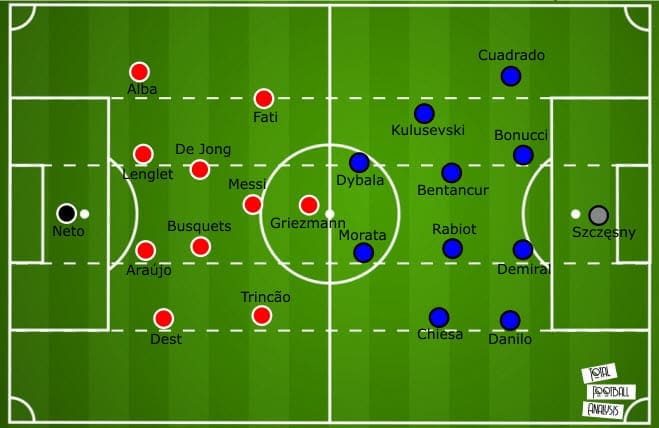
Barcelona, on the other hand, have the suspension of Gerard Piqué and the injury of Philippe Coutinho to worry about. For that reason, Ronald Araújo is set to start next to Clément Lenglet with Jordi Alba and Sergiño Dest the likely full-back pairing. However, since the former is still very fresh from injury despite playing the Clásico, the American may start on the left with Sergi Roberto manning the opposite side. Behind them, in goal, we’ll see Neto once again.
In midfield, Frenkie de Jong and Sergio Busquets is once again the likely duo, even though the latter’s poor run of form may see him dropped for Miralem Pjanić. Up front, Antoine Griezmann is set to return to the lineup with the absence of Coutinho and he will join Lionel Messi down the middle.
On the wings, Ansu Fati and Francisco Trincão could get a shot to complete Barcelona in their 4-2-3-1 structure. Of course, there is a real chance either Ousmane Dembélé or Pedri are in the lineup as well, replacing the young Portuguese star.
Juventus against Barcelona’s press
Even though Pirlo is still getting his troops to play the way he wants them to, this Juventus side do have a clear identity. They want to have the ball in their feet, build-up patiently and play from the back. We can expect the home side to alternate between a 3-2-5 and 2-3-5 depending on Barcelona’s defensive structure.
The Catalans are most likely to defend in a 4-4-2 mid-block before stepping up into a high press. Firstly, this tactical analysis will touch upon the former scenario.
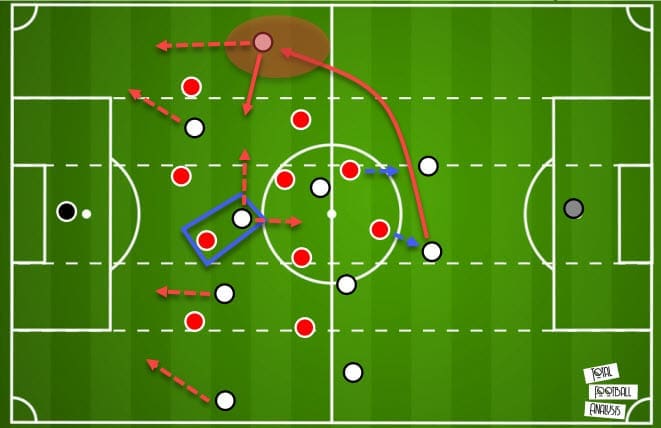
Pirlo is clear that Juventus will adhere to the rule of +1. This applies both to his attacking and defensive tactics. In possession, it means the team will have a one-player advantage – not more, not less. For that reason, their structure in the first phase of build-up will largely depend on Barcelona’s approach.
Above, you can see how Juventus are likely going to approach Barcelona’s mid-block. Initially, the Catalans like to deploy a 4-1-4-1 system that slowly transforms into a 4-4-2 as one of the midfielders jumps up, prompting the deeper pivot to join the second line. That means Juventus would start with Bonucci and Demiral in the backline with either one of the full-backs or the pivot dropping deeper once Barcelona start putting numbers into their press.
The mechanisms to advance play in this setup, however, are clear. Juventus will aim to have clear width providers on the flanks, trying to capitalise on Barcelona’s narrow structure. Even though the emphasis is on positional play, they won’t be afraid to go direct if their opposition leave so much space in their half.
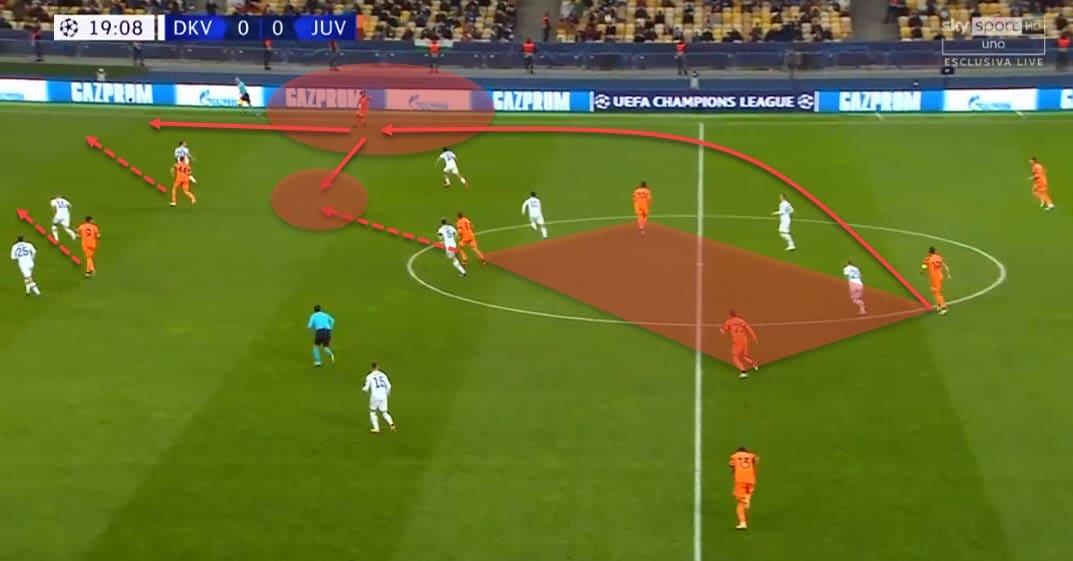
Above, you can see a very similar example against Dynamo Kyiv. Bonucci spots Cuadrado all alone on the weak side and finds him with a pinpoint pass over the top. This is also a cue for Aaron Ramsey to start moving up and into the half-space between the lines. At the same time, the forwards will make a run in-behind the opposition’s backs.
Of course, the structure was there for Juventus to build-up slowly from the back as you can see that Ramsey dropping has created a rhombus that would help them bypass the first line of press. This exact play and structure, however, are likely to be present on Wednesday against Barcelona.
The Catalans will start with one and then two players in the frontline and as Juventus form a three-man defence, it will attract another player from the second line to move up. This is when Barcelona’s 4-4-2 transforms into a 4-3-3. The game against Crotone gave us a blueprint for that scenario.
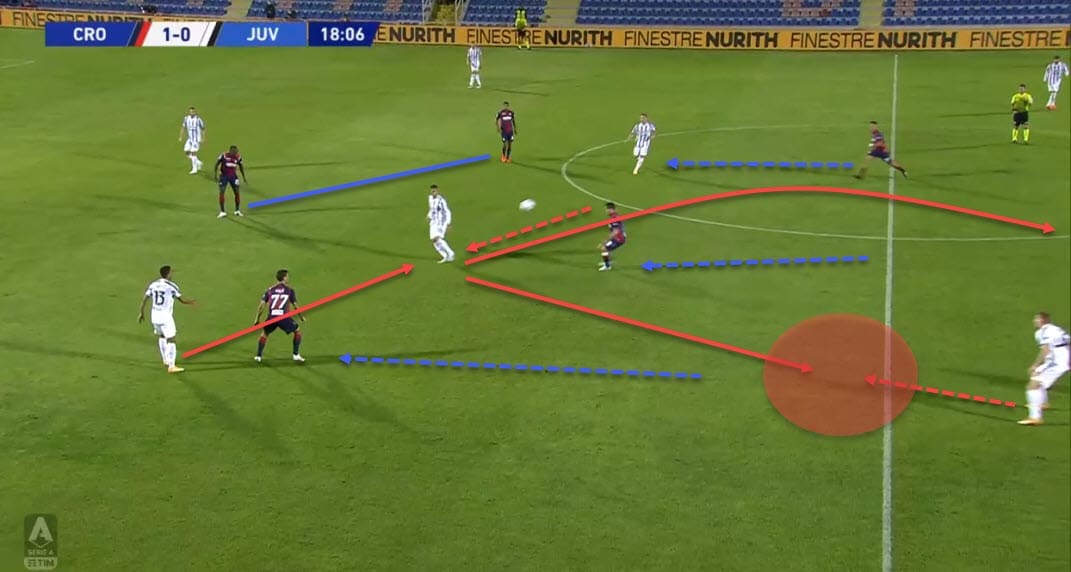
In this case, Juventus will look to advance directly through the full-backs/ wingers or, preferably, through the centre via their pivots. The example above shows us how they use the third-man principle to bypass the opposition’s cover and gain access to the man that was unavailable at first.
Note, however, that this ball can go into the dropping player or directly over the top to the man who’s holding the width. Both options are valid and should be exploitable against Barcelona’s structure. But the thing that could shift the tides into either side’s favour is the pressing.
The Catalans have vastly improved in this regard, at least as far as intensity is concerned, but are still facing game-changing issues in their approach. Below, you can see a graphic depicting the scenario higher up the pitch.
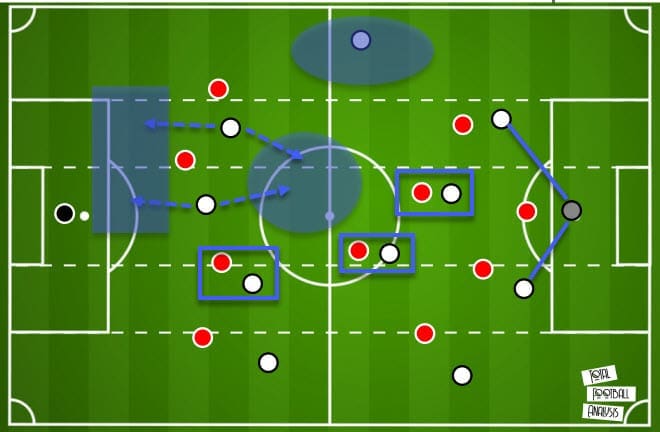
Barcelona will often start their press in a 4-2-3-1 and then alternate their approach depending on how many players does the opposition drop to aid the build-up phase. Above, I have highlighted the three players whose movement is extremely man-marking oriented. Usually, Piqué is the one to occupy the right centre-back position but with his suspension, it remains to be seen how aggressive will Araújo be in his stead.
The double-pivot, however, will certainly follow their markers or drop them altogether to burst forward and press the ball-carrier. Juventus’ advantage here, however, lies in how they use Szczęsny to escape the pres and access the free players on the flanks.
A very similar thing can be seen below with the goalie forming the three-man backline and Juventus manipulating the man-marking responsibilities of the pivots against Hellas Verona. This opens up the pockets of space behind their backs since Barcelona tend to leave huge gaps between their defensive line and the pressing squad.
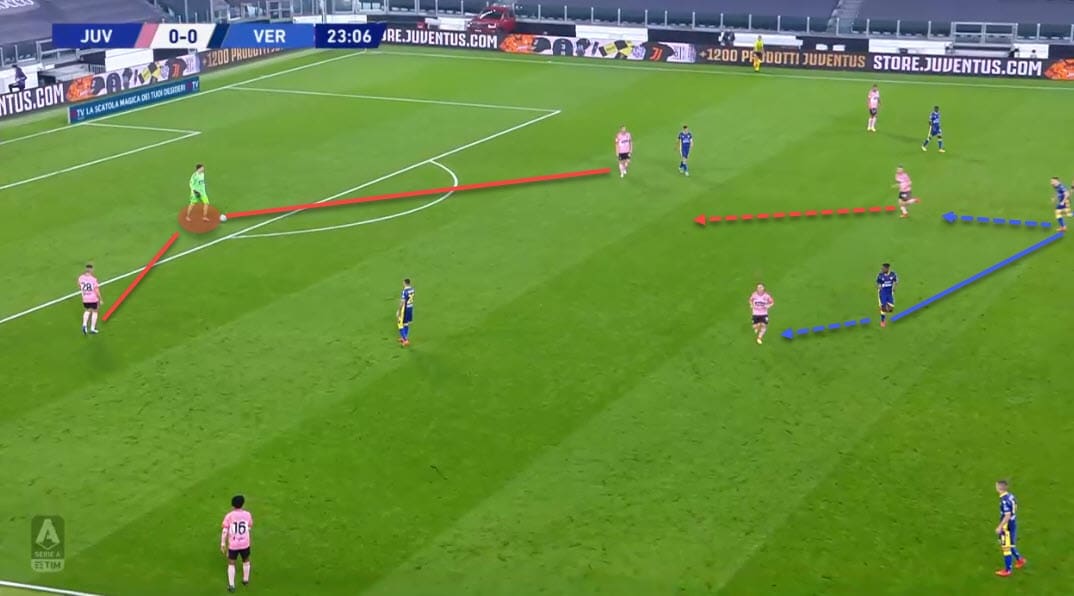
The freshest example is from the clash against Real Madrid. Notice in the following image how disjointed Barcelona’s 4-1-3-2 press is and Sergio Ramos switches the play easily. We’ve already seen Bonucci do the same against a fairly similar setup, albeit somewhat higher towards the halfway line.
With their forwards potentially dropping into those pockets to receive or running behind the opposition’s defence, Juventus could exploit this flaw to gain an advantage.
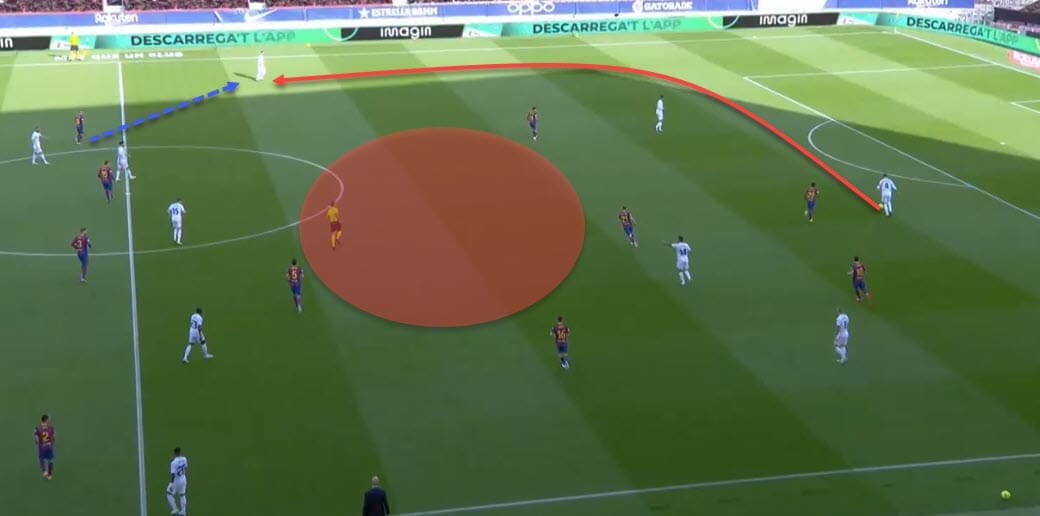
Of course, in situations like these, the press-resistance of their midfielders could be crucial. We don’t know which pairing will Pirlo choose but all of Rabiot, Bentancur and Arthur Melo could do the job decently.
We’ve seen them struggle against Verona’s high press for the majority of the game but some of their best chances were created when they successfully bypassed it and then transitioned forward from their half.
Having the likes of Dybala fit to drop and receive the ball once that happens could also be key for the hosts. Notice such an example below as Rabiot evades his marker and then Juventus progress the play in a couple of swift touches.
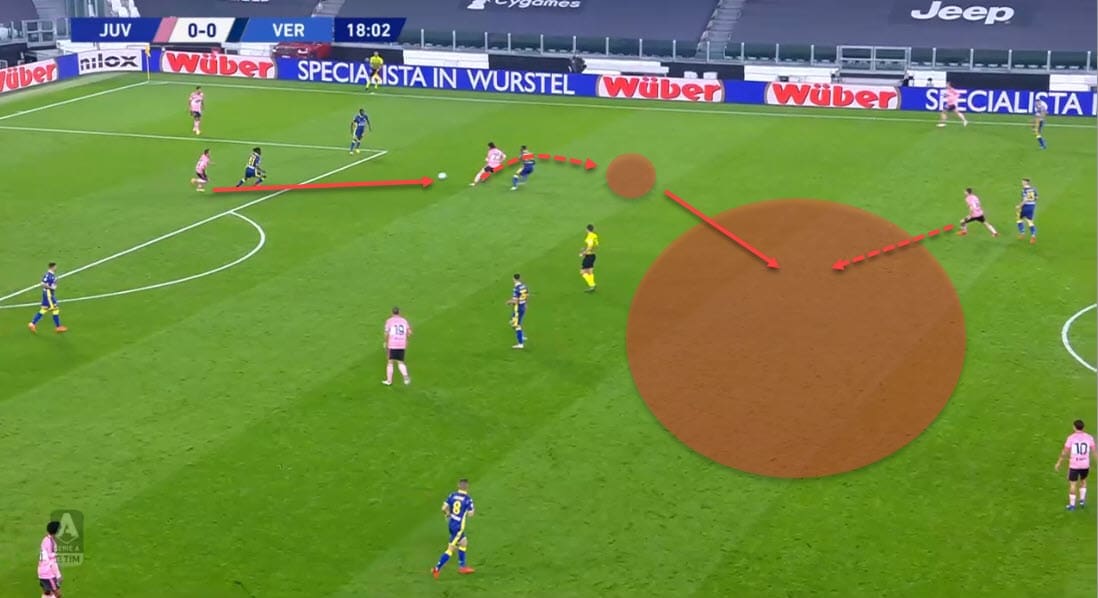
Barcelona in possession
For Barcelona, it feels there are fewer alternatives to their build-up play and tactics. The Catalans will line up in a 4-2-3-1 but will likely change to a three-man backline in the face of a 4-4-2 Juventus mid-block. The Italians won’t press them high unless the ball is deep in the opposition’s half so we can expect a similar scenario to the one below.
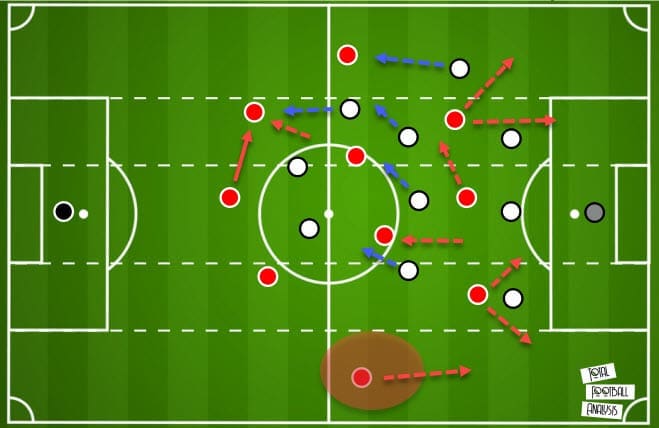
The movement of other players largely depends on the personnel. We have gone with Fati on the left, Griezmann through the centre, Messi as no.10 and then Trincão on the right. With these players in the lineup, Barcelona are likely to seek space behind the defensive line, hence the movement of the left-winger pointing upward instead of inward or deeper to receive the ball.
The same can be said for the opposite side where Barcelona will aim to get the ball. Pirlo’s 4-4-2 looks to congest central areas and force the opposition wide where they can collapse with numerical superiority. The mid-block moves as the ball circulates. Once it reaches the flanks or is deployed towards a wide man, the second line is activated.
Notice below what that looks like on the pitch. With three players in the back and the ball with the man to the right, Juventus jump from the second line to press.
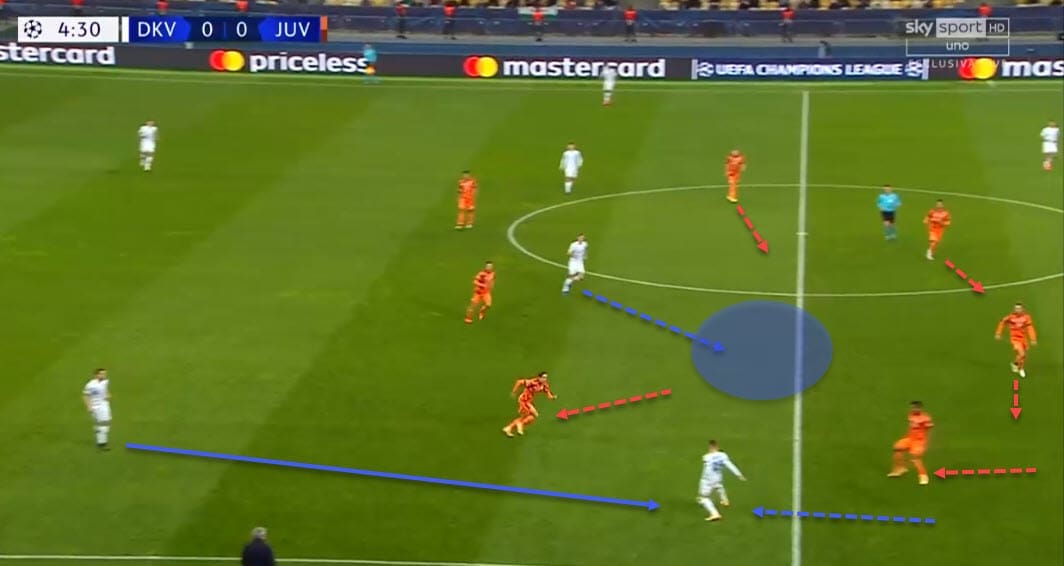
The potential for a collapse is immediately there as the midfielders and the full-back all drift to the ball area. This is the likely approach we’ll see Juventus implement tomorrow night. For Barcelona, it leaves a couple of different avenues to explore, first of which is fast ball circulation.
As we’ve mentioned earlier in this tactical analysis, Pirlo likes to congest the centre of the pitch and usually, that means the flanks are open if they can be accessed quickly. In normal circumstances, that would be a problem for Barcelona since they seem to be struggling with using their wings properly, courtesy of the lack of natural wingers in the team.
But with potentially both Fati and Trincão/ Dembélé on the pitch, this could suddenly turn into a real possibility. Notice below how Verona take advantage of the same thing. With Juventus only having two players in the frontline, the opposition’s third defender can run with the ball and get into a situation similar to this one.
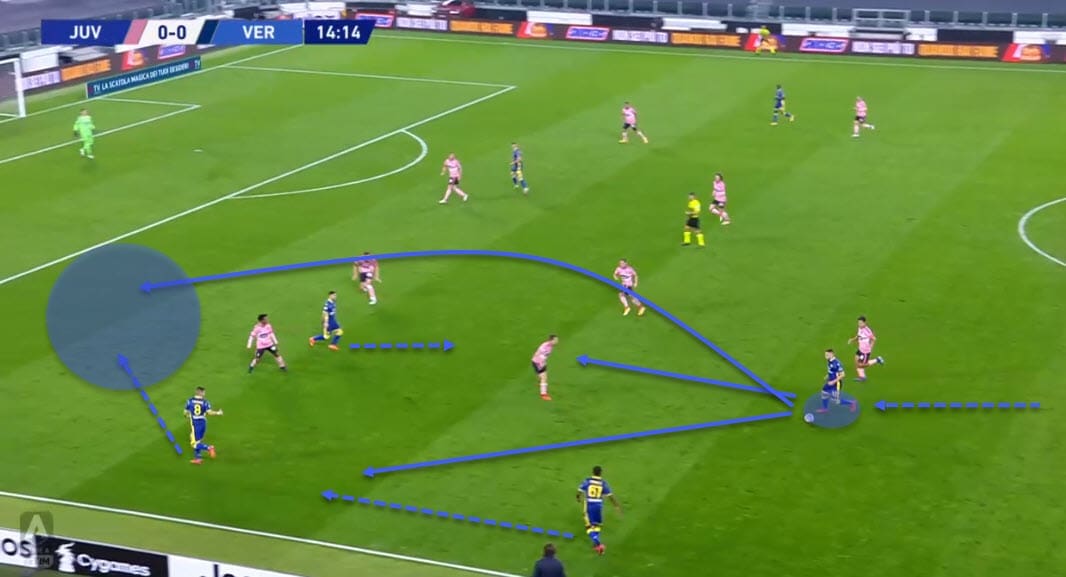
The ball-carrier has three options ahead of him – pass to the full-back on the left, to the dropping teammate or the one bursting into space behind the opposition’s backline. The key is the opposite movement of players which helps confuse the defenders and drags them away, potentially setting the scene for a 1v1 duel out wide.
This would also depend on the players Koeman chooses tomorrow. Some like Pedri or the injured Coutinho like to drop to receive while others like Dembélé and Alba like to run into space. Players like Fati, however, can do both equally well. Even if it’s only Alba on the left or even Dest, Barcelona can still utilise this kind of move to breach the block.
After all, it’s one of their favourite tactics in the final third, mostly involving Messi and Alba. We’ve seen a rather similar thing against Real Madrid and it resulted in an equalising goal for the Catalans.
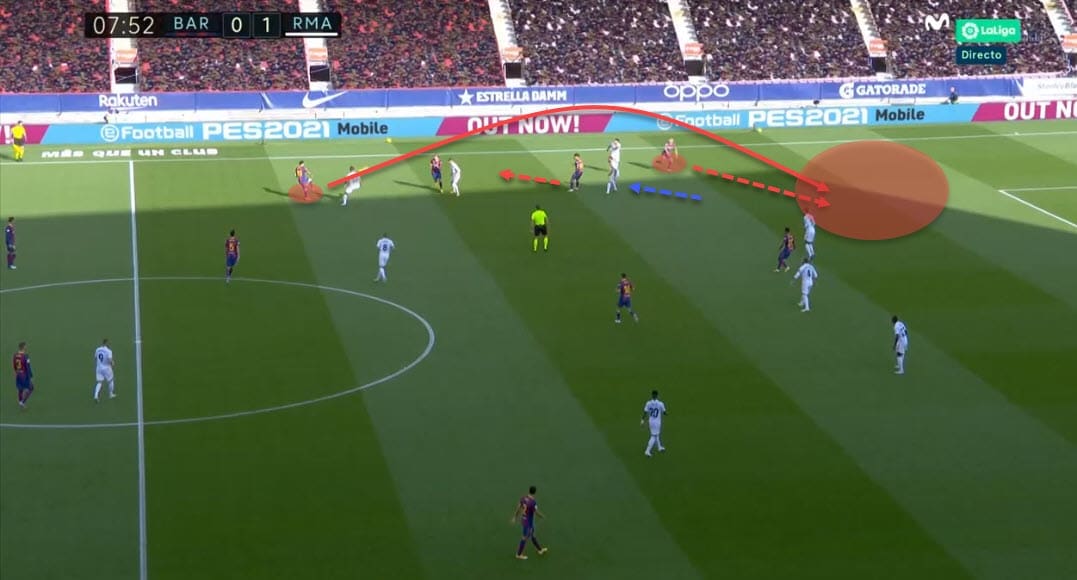
It will be crucial for Barcelona to use Juventus’ man-marking centre-backs who love to jump out to dispossess the opposition forward. When facing such a tight block with heavy man-marking tactics in the backline, movements like the one above are key.
If the Catalans can utilise the opposite movement with the combinations like Fati/ Alba and Trincão/ Dest, they should be able to manipulate the backline and create overloads or isolated 1v1 duels out wide.
Here’s an example of Bonucci jumping out to meet his man higher up the pitch following Verona’s attempt to find him in the half-space from the deep.
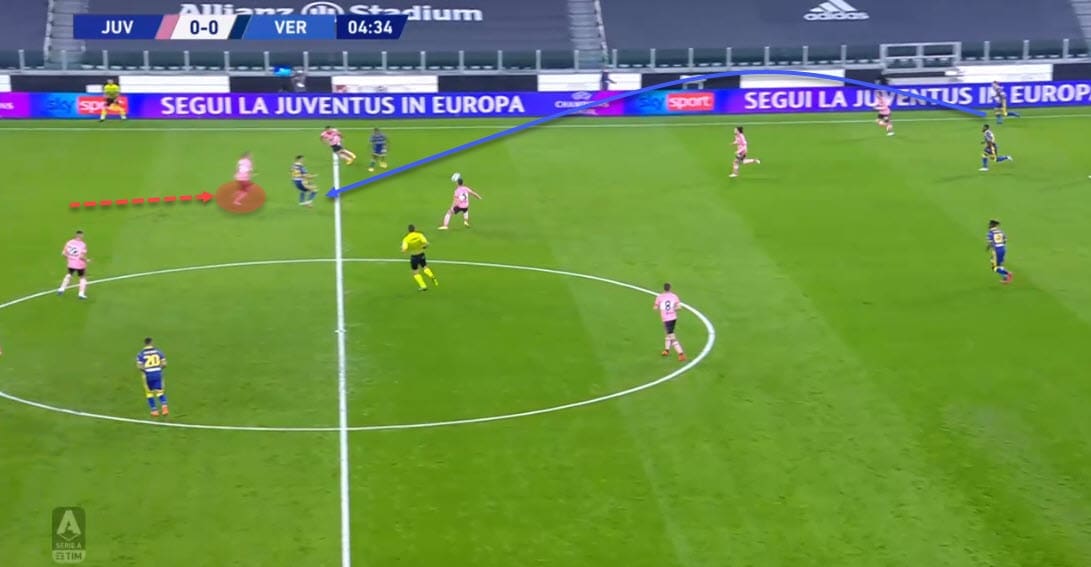
Final prediction
Neither team is in red-hot form and both are facing some difficulties in terms of tactics and available personnel. Of course, for Juventus, Ronaldo surprisingly entering the squad would have a major impact on the clash.
So far, however, it looks like we won’t be seeing a Messi vs Ronaldo duel tomorrow in Turin. With all of that being said, this game is looking like a 1-1 draw or a 2-1 victory for the hosts. But with so many variables still being in the air, it’s really difficult to successfully predict the scoreline.





Comments